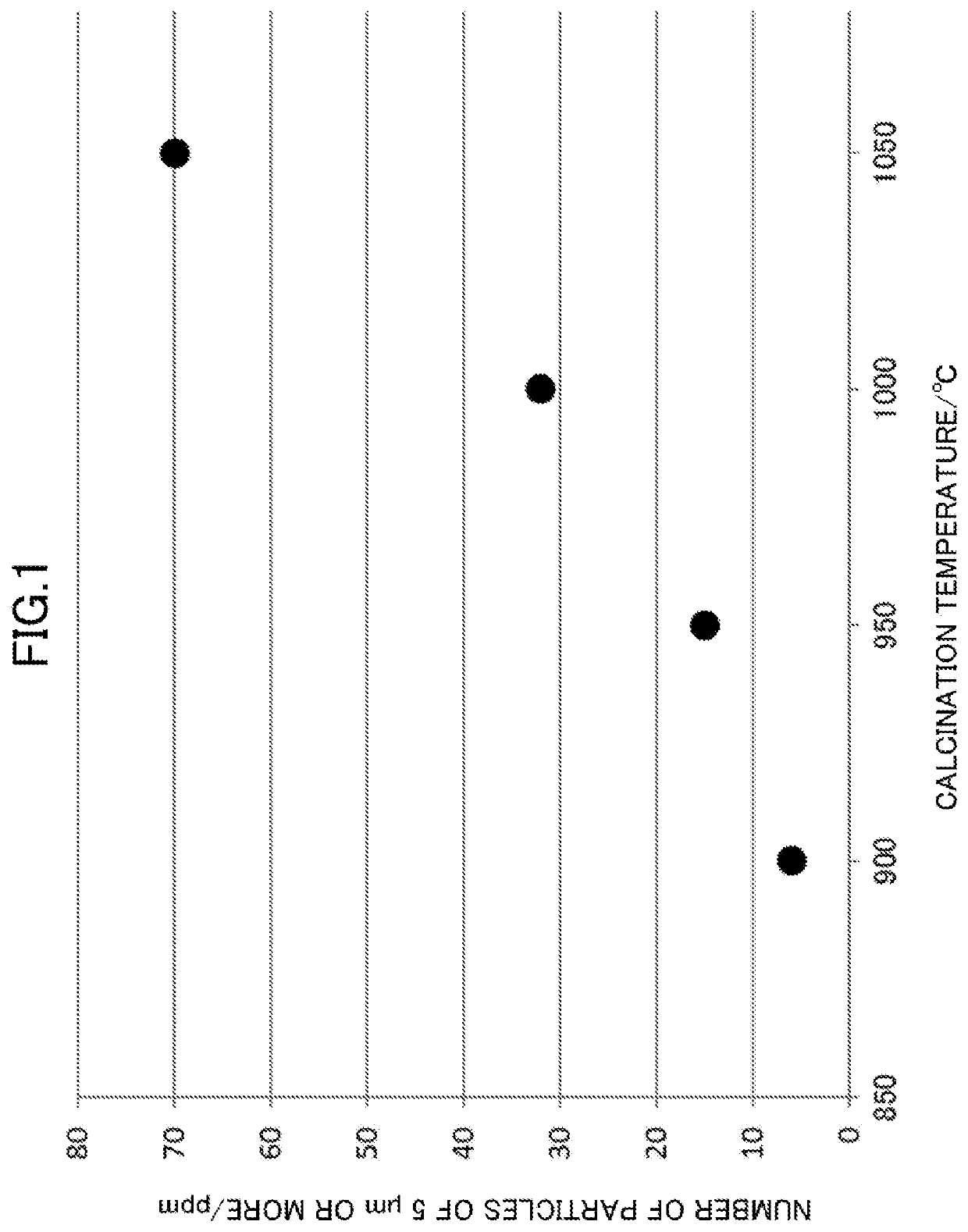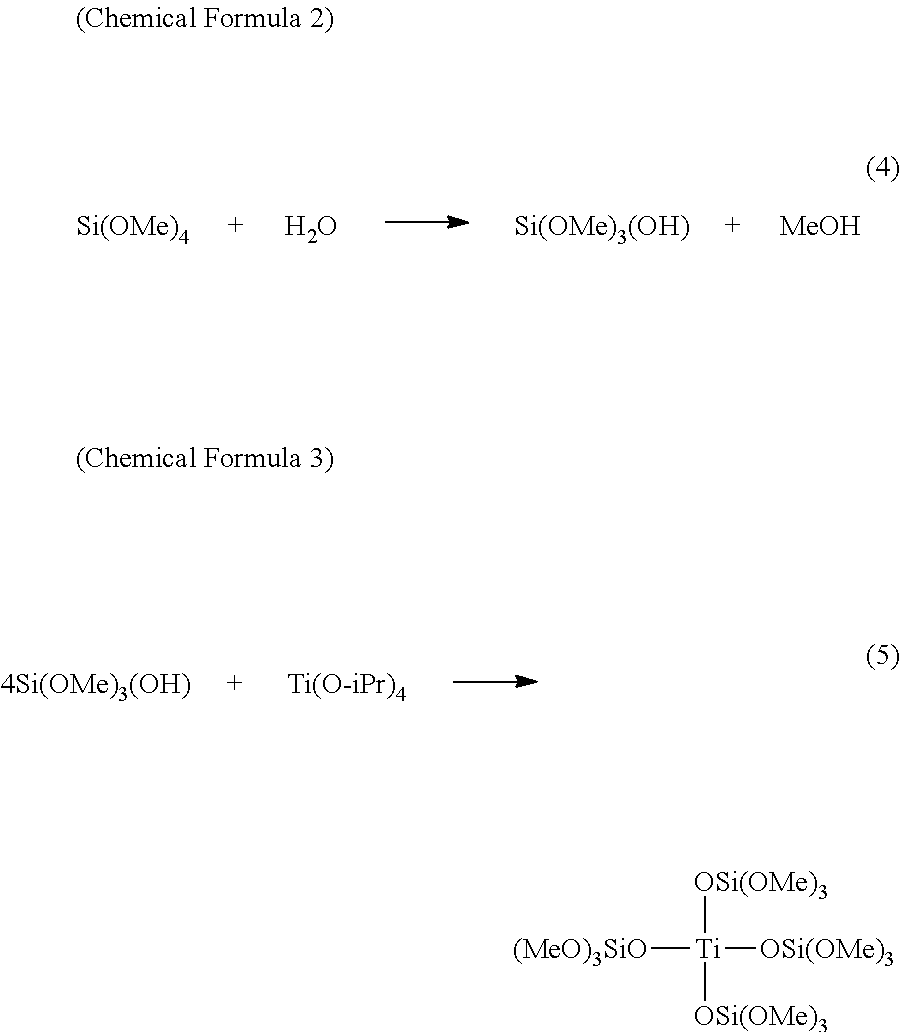Composite oxide powder and method for production thereof
a composite oxide powder and oxide powder technology, applied in the direction of silicon oxides, silicon compounds, instruments, etc., can solve the problems of poor adhesion, defects and scratches, coarse particles acting as obstructive factors, etc., to improve the productivity and yield of the intended members, reduce defects, and great ability
- Summary
- Abstract
- Description
- Claims
- Application Information
AI Technical Summary
Benefits of technology
Problems solved by technology
Method used
Image
Examples
example 1
[0335]In a 3 L four-neck glass flask, 475 g of tetramethoxysilane (methyl orthosilicate manufactured by Tama Chemicals Co., Ltd., will be hereinafter referred to as “TMOS”) as metal alkoxide was charged, to which 238 g of methanol as an organic solvent (11 mass % relative to the mass of an inorganic oxide particle dispersion) and 56 g of 0.035 mass % hydrochloric acid as an acid catalyst (0.003 mass % as a content of hydrogen chloride relative to the mass of metal alkoxide) were added. Then, the mixture was stirred at room temperature for 10 minutes to hydrolyze TMOS. Subsequently, to the resulting mixture, a liquid obtained by diluting 250 g of titanium tetraisopropoxide (A-1 manufactured by Nippon Soda Co., Ltd., will be hereinafter referred to as “TPT”) as metal alkoxide with 500 g (23 mass % relative to the mass of the inorganic oxide particle dispersion) of isopropyl alcohol (will be hereinafter referred to as “IPA”) was added, to obtain a transparent composite alkoxide solutio...
example 2
[0340]Steps performed after the calcination in Example 1 were skipped.
[0341]The obtained silica-titania composite oxide powder had a mean particle diameter of 0.47 μm, coefficient of variation of 24%, a sphericity of 0.92, and a refractive index of 1.59, and no coarse particles having a particle diameter of 5 μm or more were detected by the laser diffraction scattering method. The respective amounts of coarse particles having particle diameters of 5 μm or more and 3 μm or more measured by the Coulter counter method were less than 4 ppm and 5 ppm.
[0342]The amount of heating loss was 18%. The α ray emission was 0.002 c / (cm2·h). As for the impurities, the U content was 0.02 ppb, the Th content was 0.01 ppb, the Fe content was 0.1 ppm, the Al content was 0.0 ppm, the Na content was 0.2 ppm, the K content was 0.0 ppm, the Ca content was 0.1 ppm, the Cr content was 0.0 ppm, the Ni content was 0.0 ppm, and the Cl− content was 0.1 ppm. No flow marks were found.
example 3
[0343]Silica-zirconia composite oxide powder was synthesized in the same manner as in Example 1 except that 180 g of tetra-n-butoxyzirconium (TBZR manufactured by Nippon Soda Co., Ltd. (will be hereinafter referred to as “TBZ”)) was used in place of 250 g of TPT, and the amount of hydrochloric acid was changed to 30 g. Thus, 238 g of silica-zirconia composite oxide powder was obtained.
[0344]The obtained silica-zirconia composite oxide powder had a mean particle diameter of 0.32 μm, a coefficient of variation of 19%, a sphericity of 0.95, and a refractive index of 1.53, and no coarse particles having a particle diameter of 5 μm or more were detected by the laser diffraction scattering method. The respective amounts of coarse particles having particle diameters of 5 μm or more and 3 μm or more measured by the Coulter counter method were 9 ppm and 32 ppm.
[0345]The amount of heating loss was 3%, and the amount of isolated silanol groups was 0.6. The α ray emission was 0.002 c / (cm2·h). A...
PUM
| Property | Measurement | Unit |
|---|---|---|
| diameter | aaaaa | aaaaa |
| particle diameter | aaaaa | aaaaa |
| particle diameter | aaaaa | aaaaa |
Abstract
Description
Claims
Application Information
 Login to View More
Login to View More - R&D
- Intellectual Property
- Life Sciences
- Materials
- Tech Scout
- Unparalleled Data Quality
- Higher Quality Content
- 60% Fewer Hallucinations
Browse by: Latest US Patents, China's latest patents, Technical Efficacy Thesaurus, Application Domain, Technology Topic, Popular Technical Reports.
© 2025 PatSnap. All rights reserved.Legal|Privacy policy|Modern Slavery Act Transparency Statement|Sitemap|About US| Contact US: help@patsnap.com



